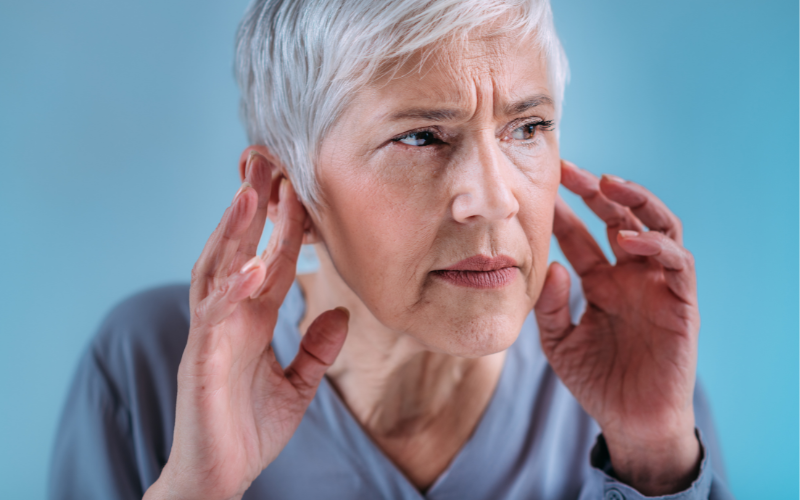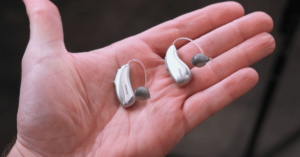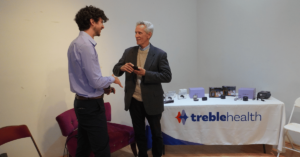Hearing loss is typically considered a permanent condition, or an irreversible state, but is that true? Is it possible to reverse hearing loss? Because there are many different types of hearing loss, which we will explore in greater detail below, the answer to this question is highly nuanced. Lost hearing can be restored in some cases, but remains a permanent fixture in others. What are the different types of loss and how are they managed or treated? We’ll look at these questions and more below.
How Does The Ear Work?
The ear is made up of three different parts: the outer, middle, and inner ear. Because there are so many different parts of the ear, there are many different ways for hearing loss to occur–and many different ways to go about hearing restoration. The outer ear is the portion of the ear that most people are familiar with; it is the part of the ear where foreign objects enter the ear, where piercings are delivered, and where you can easily see the different parts of the ear. The middle ear involves the ear canal and some ear bones and other components. Finally, the inner ear involves the sensory hair cells and auditory nerve housing that is largely responsible for interpreting sound and communicating with the central nervous system.
Loss of hearing occurs when any part of the ear is not functioning properly. When the different parts of the ear are not working properly, the brain cannot properly process sound–resulting in hearing loss or hearing impairment. Before you can fully understand the different types of hearing impairment and loss that exist, you must understand the components of the inner, middle, and outer ears, and how they come together to take in and process sound waves.
The part of the ear that is malfunctioning or damaged will help identify the type of loss that is at play, and will subsequently determine if reversing hearing loss is possible, and if it is a realistic expectation to restore hearing.
Anatomy Of The Ear
As briefly mentioned above, there are three basic parts of the ear: the outer, middle, and inner ear. Each of these portions of the ear possesses its own significant aspect of hearing that can negatively or positively impact the ability to hear. Although the inner portion of the ear is often considered the most significant aspect, there other components provide a fundamental barrier to the innermost portion of the ear, and auditory loss treatment can involve all parts of the ear. We’ll more clearly identify the different parts of the ear and their function below.
Outer Ear
The outer ear is made up of the pinna, ear canal, and ear drum, or tympanic membrane. This is the portion of the ear that many people think of when they think about the ear as a whole, and is the portion of the ear that is most frequently infected and impacted by external factors, like ear wax.
Middle Ear
This part of the ear is made up of the ossicles, (tiny middle ear bones), the eardrum or tympanic membrane, and the eustachian tubes. The middle of the ear is another frequent spot for infections, and this can be the location for conductive hearing losses.
Inner Ear
The inner ear (or cochlea) is made up of cochlear hair cells, auditory nerve endings, and the semicircular canals, which are responsible for the vestibular system (balance function). Hair cell regeneration is one of the primary goals and focuses of treatment that seeks to improve the health of this portion of the ear and thereby restore hearing or auditory function.
Types Of Hearing Loss

There are different types of hearing loss, each of them related to different parts of the ear, and derived from different sources. The types include:
Sensorineural Hearing Loss
Sensorineural loss occurs within the inner ear, and is typically considered permanent. Often related to loud noise exposure, age-related loss, illness, injury, congenital defects, and infection, sensorineural loss is not usually considered amongst the candidates for improvement via inner ear regeneration.
Conductive Hearing Loss
This type of loss involves the middle ear structures and most often results in temporary loss of hearing. This can occur in equal measure across all populations, and is typically related to infection, fluid in the ear, damage to bones in the ear, a hole or perforation in the eardrum, or another type of damage to these parts of the ear.
Mixed Hearing Loss
Mixed hearing loss involves both the inner portion and middle and/or outer portions of the ear, and describes the condition in which conductive and sensorineural loss issues are at the root. This can happen in a mature mammalian inner ear and in children, though more severe hearing loss is more likely to be in older populations.
If And How Each Type Of Loss Can Be Reversed
While the restoration of hearing can be something of a loaded or complicated topic, there is potential for healing of sudden hearing loss and other forms of the condition. Depending on the state of the tiny hair cells within the ear, the health of ear structures, and more, different types of loss can be addressed and aided in different ways. Each type requires its own unique type of intervention in order to resolve.
Sensorineural Hearing Loss
As of the time of this writing, this type of loss is not reversible. Reversing this form of hearing loss can be a hot topic in research studies and papers, and clinical trials continually work to resolve the issues leading to this type of loss. Nevertheless, the permanent damage to cochlear hair cells and damage to the auditory nerve result in permanent hearing loss, without a reliable means to regrow cells responsible for hearing improvement. Currently, treatment involves cochlear implants or assistive hearing devices, rather than any type of surgery or medication.

One study published by Harvard Medical School relayed a new strategy used to “reprogram” cells in the inner ears of mature mammalian inner ear (mice, specifically), to spur regeneration. This proof-of-concept study is significant, because it demonstrates that it may be possible to reverse this particular type of loss and achieve cell division and regeneration.
Although this particular study is promising and offers some hope, reversing sensorineural hearing loss is not yet an achievable goal in human subjects, and requires more research and data collection, it does provide hope for millions of people worldwide who have lost hearing in this way.
Conductive Hearing Loss
This type of loss is typically reversible, because it is usually caused by middle ear disorder or dysfunction, where an object or inflammation is obstructing sound vibrations and preventing them from traveling through the outer or middle ear system to reach the healthy or intact inner ear properly. Conductive losses are often reversible or treatable using medicine or surgical procedures. The most common types of conductive loss include infection (otitis externa or otitis media), otosclerosis, a buildup of earwax, or abnormal bony growths in the ear canal (called exostoses).
Mixed Hearing Loss
Mixed hearing loss can be partially reversed. It is caused by a combination of sensorineural and conductive hearing loss, and can impact the inner or middle ear. Because it is a mixed disorder that is able to affect the structure of ears, infection or damage to the ears, or an impaired auditory nerve, mixed hearing loss frequently uses a multi-pronged approach to treatment. At present, hair cell regeneration and cell division procedures are not utilized; instead, the sensorineural aspect of mixed loss is treated using hearing aids. Ear, head, or neck surgery can be used to address conductive losses, as can medication.
Hearing Loss And Its Impacts

Hearing loss, tinnitus, and other conditions affecting hearing and the ear can be difficult to narrow down and successfully treat, and many people who experience changes to hearing also experience significant changes to mood and mental health. Consequently, addressing hearing-related issues is paramount, both to ensure that mental health is supported, and to ensure that other possible complications such as vertigo and balance issues are adequately supported, as well.
While innovations in the field of auditory health and medicine are exciting in fully mature mammalian studies, there is still much that remains unknown about treating some forms of hearing loss. A surgical procedure can be used to correct some conductive loss issues, while a hearing aid can address sensorineural losses in the absence of sufficiently reprogrammed cells. Whether the loss of hearing exists in isolation or comes along with other issues affecting hearing such as tinnitus, as well, the impacts to day to day life can be significant, and undergoing surgery, tinnitus treatment, or hearing aid fitting and utilization can positively affect quality of life and overall hearing ability.
While not all forms of loss are currently curable, all are manageable, and connecting with the right healthcare professionals–from primary care physicians to audiologists–can make all the difference in repairing hearing health and continuing to experience further difficulty.











